The Rise of Hybrid Work
Hybrid work models reshape office productivity. Employees now split time between home and office. Devices must support seamless transitions. Multi-port dual monitor dock stations emerge as essential tools. They integrate multiple devices, power delivery, and display outputs. Such docks reduce cable clutter and improve efficiency. Furthermore, these solutions align with modern workflow demands, enabling consistent performance across diverse environments.
Enhancing Connectivity and Device Integration
Multi-port dock stations connect laptops to monitors, peripherals, and networks simultaneously. USB-C, HDMI, DisplayPort, and Ethernet ports consolidate connectivity. Users can link external storage, printers, and webcams without adapters. This integration ensures consistent productivity. Moreover, dual monitor support allows multitasking across applications. The dock acts as a central hub, streamlining device management in hybrid offices.
Boosting Productivity with Dual Monitors
Dual monitor setups significantly enhance workflow efficiency. Multi-port dock stations support high-resolution displays for extended desktops. Employees can manage spreadsheets, communication apps, and creative software simultaneously. This arrangement reduces window switching and cognitive load. Consequently, work quality and output speed improve. Dual monitors, combined with a versatile dock, create a productive hybrid office ecosystem.
Power Delivery and Device Charging
Modern multi-port docks provide power delivery for laptops and mobile devices. USB-C ports offer high wattage charging while maintaining data throughput. This eliminates the need for multiple chargers. Employees benefit from uninterrupted work sessions. Additionally, consistent power delivery protects battery health. The dock thus becomes both a connectivity hub and a reliable power source, essential for mobile hybrid workflows.
Simplifying Cable Management
Hybrid work often leads to cluttered desks. Multi-port dock stations consolidate cables and peripherals into a single connection. Users connect the dock to a laptop, and all devices link instantly. This reduces setup time, simplifies troubleshooting, and maintains a clean workspace. Cable organization improves ergonomics and minimizes wear on connectors, enhancing device longevity.
Supporting Peripheral Expansion
Employees increasingly rely on external peripherals. Multi-port docks accommodate multiple USB devices, card readers, and audio equipment. This flexibility supports diverse workflows, from creative tasks to video conferencing. Peripheral expansion ensures users can tailor setups to individual needs. Consequently, dock stations enhance both adaptability and user satisfaction in hybrid environments.
Compatibility Across Devices and Platforms
Dock stations support multiple operating systems, including Windows, macOS, and Linux. Universal compatibility ensures seamless switching between personal and office laptops. Hybrid workers avoid connectivity interruptions. Additionally, plug-and-play functionality reduces technical barriers. Users can adapt quickly, making dock stations valuable for multi-device environments and collaborative offices.
Enhancing Remote Collaboration
Hybrid offices demand reliable remote collaboration tools. Multi-port dock stations facilitate high-quality video and audio for meetings. Multiple monitors allow simultaneous document sharing and video conferencing. This setup enhances communication and reduces delays. Furthermore, seamless peripheral integration improves workflow continuity during hybrid meetings.

 Security and Data Management
Security and Data Management
Many multi-port dock stations offer secure connections for networked devices. Built-in Ethernet ports and centralized USB connections help protect data. Users avoid constant plugging and unplugging, reducing the risk of data loss. The dock also centralizes device monitoring and management. As a result, hybrid work remains both efficient and secure.
Scalability for Office Expansion
Dock stations scale with evolving office requirements. Adding dual monitors or extra peripherals is simple. IT teams can deploy identical solutions across multiple workstations. This standardization reduces support costs and accelerates onboarding. Multi-port dual monitor dock stations thus support both individual productivity and organizational growth.
Future Trends in Hybrid Work Docking Solutions
Emerging dock technologies focus on wireless connections, higher resolution displays, and faster data transfer. Hybrid offices increasingly adopt USB4 and Thunderbolt docks for improved performance. Dock stations continue to integrate smart power management and AI-assisted device recognition. These innovations reinforce the dock’s central role in hybrid work ecosystems.
Conclusion: Strategic Value of Multi-Port Dual Monitor Docks
Multi-port dual monitor dock stations deliver connectivity, efficiency, and adaptability. They simplify hybrid workflows, enhance productivity, and support peripheral expansion. Reliable power delivery and cable management improve user experience. As hybrid work evolves, dock stations become essential infrastructure, bridging home and office environments. Investing in versatile docks ensures sustained performance and scalable office solutions.



